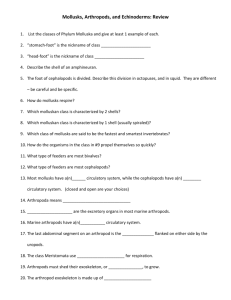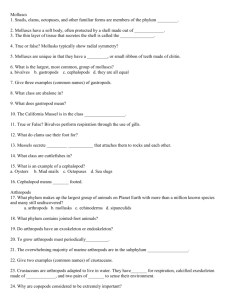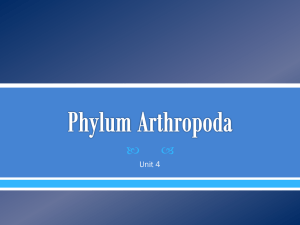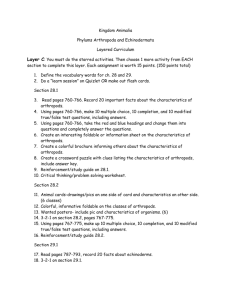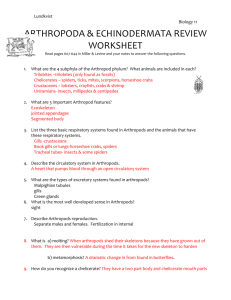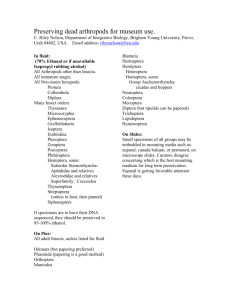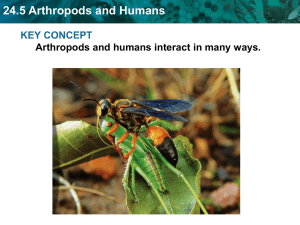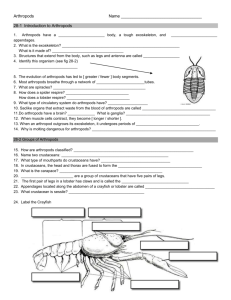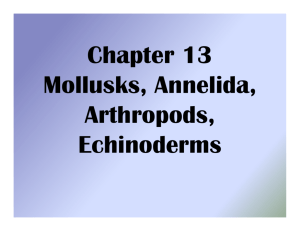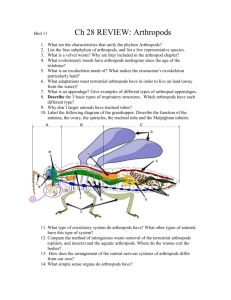Abdomen Thorax Head
advertisement
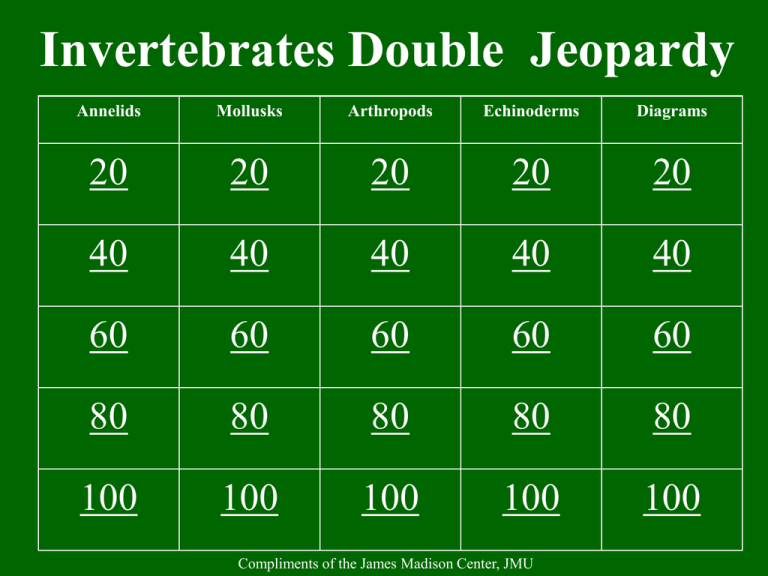
Invertebrates Double Jeopardy Annelids Mollusks Arthropods Echinoderms Diagrams 20 20 20 20 20 40 40 40 40 40 60 60 60 60 60 80 80 80 80 80 100 100 100 100 100 Compliments of the James Madison Center, JMU What features distinguish annelids from roundworms? Unlike roundworms, annelids have segmented bodies and a true coelom that is lined with mesoderm. List the defining characteristic for each class of annelid. Oligochaetes typically have fewer setae than polychaetes and live in soil or fresh water. Leeches are typically external parasites that suck the blood and body fluids of their host. Polychaetes are marine annelids that have paired, paddlelike appendages tipped with setae. Describe the feeding strategies of earthworms and leeches. Earthworms use their pharynxes to suck soil and detritus into their esophagus. Leeches suck the blood and body fluids of their host. How do roundworms excrete digestive waste and cellular wastes? Digestive waste passes out the anus at the end of the digestive tract; Cellular waste containing nitrogen is eliminated by nephridia, which are excretory organs that filter fluid in the coelom. An earthworm has more light-sensitive cells in its anterior and posterior segments than in other parts of its body. Explain how this is advantageous for the worm. Having more light-sensitive cells in the front and back ends is advantageous, because the animal moves forward and may be attacked by a predator from the rear. What is a mollusk? A mollusc is a soft-bodied animal that usually has an internal or external shell. List and describe the four parts of the mollusk body plan. Foot, mantle, shell, visceral mass. The muscular foot can have different forms, e.g., spade-shaped; mantle is a thin tissue layer covering most of the mollusk’s body; shell, when present, made of calcium carbonate; visceral mass is internal organs. Describe the main characteristics of the three major classes of mollusks. Gastropods – shell-less or one shell, ventral foot; bivalves – two shells; cephalopods – head attached to foot. Why are land snails restricted to moist environments? Land snails respire using a mantle cavity that has a large surface lined with blood vessels. Because this lining must be kept moist, it confines land snails to moist places. Compare open and closed circulatory systems. Why are open circulatory systems found mostly in small animals that move slowly? In an open system, blood is pumped through vessels by a simple heart and works its way through different sinuses. In a closed system, blood is circulated through a network of blood vessels. A closed system supports greater oxygen needs because blood moves more quickly through the body. What are the main features of arthropods? Arthropods have a segmented body, a tough exoskeleton, and jointed appendages. Describe the process of digestion in spiders. Spiders first inject enzymes to liquefy their food, then suck the tissues into a specialized pumping stomach, which forces the liquid through the rest of the digestive system. How is the process of molting related to growth in arthropods? During molting, an arthropod sheds its entire exoskeleton and manufactures a larger one to take its place. This process creates room for growth. What organs are used in arthropod respiration? Which are found in terrestrial arthropods? Aquatic arthropods? Most terrestrial arthropods breathe through tracheal tubes. Other terrestrial arthropods respires using book lungs. Most aquatic arthropods respire through featherlike gills. The horseshoe crab respires through organs called book gills. How do the three largest groups of arthropods differ? Crustaceans: two pairs of branched antennae, two or three body sections, and chewing mouthparts called mandibles; Chelicerates: have mouthparts called chelicerae and two body sections, and nearly all have four pairs of walking legs; Uniramians: jaws, one pair of antennae, and unbranched appendages. What is an echinoderm? An echinoderm has a spiny skin, an internal skeleton, and a water vascular system with tube feet. Most have fivepart radial symmetry. What is the water vascular system? How is it important to echinoderms? The water vascular system is a system of internal tubes. The system carries out respiration, circulation, and movement. List the major classes of echinoderms and describe their characteristics. Sea urchins and sand dollars have plates that form a box around their internal organs. Brittle stars have long, flexible arms and can move quickly. Sea cucumbers look like cucumbers. Sea stars move by creeping slowly and can repair themselves when damaged. Sea lilies and feather stars have a stalk by which they attach to the ocean floor. Echinoderms are deuterostomes. What does this indicate about their relationship to other animals? Echinoderms are more closely related to chordates than to other invertebrates, most of which are protostomes. Why is tearing a sea star apart and throwing it back into the water an ineffective way of trying to reduce sea star populations? If a sea star is pulled into pieces, each piece will usually grow into a new animal. Label the following: Insert Text for Question Category 5 – 40 points Insert Text for Question Category 5 – 60 points Antennae Compound Eye Mouth Palps Spiracles Abdomen Thorax Head Insert Text for Question Category 5 – 100 points
